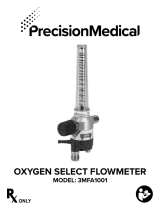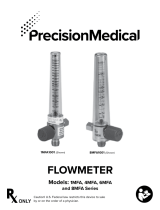
- 5 -
Air-Oxygen Blender
SECTION 2: TECHNICAL DESCRIPTION
The Air-0xygen Blender is a medical device used to mix Medical Air and USP Oxygen into a gas
source ranging from 21% - 100% oxygen. The inlet gas connections are standard DISS or NIST
foreachgas.TheinletsareclearlymarkedandlabeledonthebottomoftheBlender.Theoutlets
are standard DISS male oxygen connections.
The front panel of the Blender is designed has a dial that is used to set the specific FIO2 blend.
The dial settings range from 21% oxygen to 100% oxygen.
The Path of the Gases
The supply enters through the air and oxygen inlet connectors located on the bottom of the
Blender.Eachinletconnectorcontainsaparticulatefilterandduckbillcheckvalveswhichprevent
possible reverse gas flow.
Diaphragm Housing Module
The two gases then enter the two-stage pressure Diaphragm Housing Module. In this module,
thepressuresofbothgassourcesareequalizedpriortoenteringtheProportioningModule.The
pressureisequalizedatthelowerpressure.Thediaphragmwithinthemodulerespondstothe
differenceinpressureanddirectsthemovementofeachcheckvalveassemblycontainedwithinthe
air and oxygen chambers. The movement of each ball adjusts the amount of gas flowing through
the Diaphragm Housing
Module,equalizingtheairandoxygenpressurestothelowerpressure.
Proportioning Module
From the Diaphragm Housing Module the gases flow into the Proportioning Module and are mixed
according to the oxygen percentage selected on the Oxygen Concentration Dial. The Proportioning
Module consists of a double ended valve positioned between two valve seats. One seat controls
the passage of air and the other valve seat controls the passage of oxygen into the outlet. At this
point, the two gases have been blended according to the oxygen percentage selected on the
Oxygen Concentration Dial.
WiththeOxygenConcentrationDialatthefullcounterclockwiseposition(21%),thedoubleended
valve will completely close off the flow of oxygen, allowing only the air to flow. By adjusting the
OxygenConcentrationDialtothefullclockwiseposition(100%),theflowofairisblocked,permitting
only the flow of oxygen through the Blender outlet.
Alarm and Alarm Bypass
An audible alarm located on the bottom of the Blender that signals when the difference in pressure
between the two inlet gasses exceeds 20 psi.
Whenthetwosourcegasesarenearequalinpressure,thealarmbypasspoppetispositionedover
thebypasschannel,blockingtheflowofbothgases.Thepoppetwillremainseatedforunequal
pressuresupto20psi(1.41kg/cm2).Oncea20psi(1.41kg/cm2) difference is sensed by the
poppet, the higher gas pressure will overcome the spring force and pressure will overcome the
spring force and pressure at its opposite end, thus creating a path for gas (air or oxygen) to flow
into the alarm channel. The gas with the higher pressure will also flow directly to the Blender outlet
port by passing the Balance and Proportioning Modules. The gas is also directed to the bottom
of the unit to the reed alarm, thus creating and audible warning. The oxygen concentration will
be that of the gas at the higher pressure. The Blender in the alarm/bypass mode will deliver the
oxygen (100%) or air (21%) until the bypass mechanism resets when the source gas pressure is
restoredtoadifferentialofapproximately6psi(0.42kg/cm2).
If the Blender is set at 21% and the OXYGEN source pressure is reduced sufficiently to produce
a20psi(1.41kg/cm2) or greater differential, the unit will not alarm because it will continue to
deliver 21% concentration according to the setting. If the control is moved slightly from the 21%
setting, the alarm will sound.
Similarly, if the Blender is set to deliver 100% oxygen concentration and AIR source pressure
is reduced or lost, the unit will not alarm because it will continue to deliver the selected 100%
concentration. The alarm will not function when there is no flow to the Blender.


































